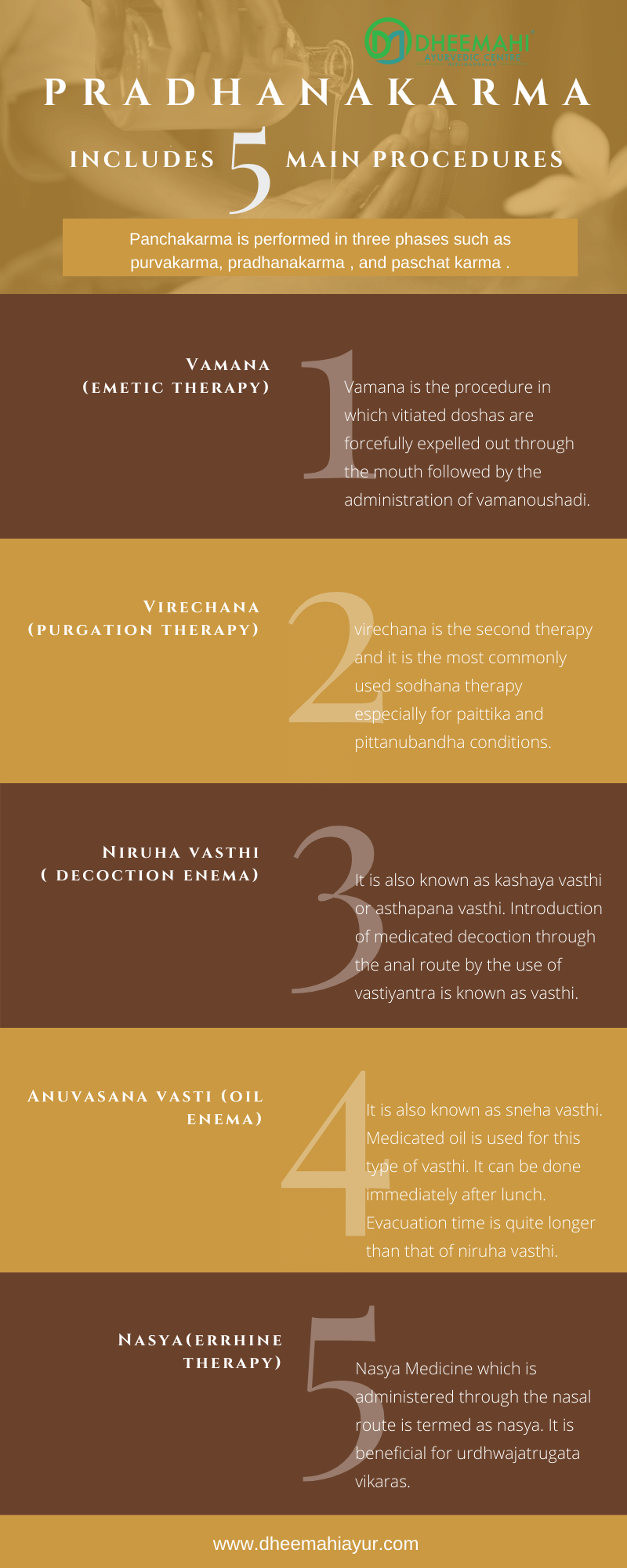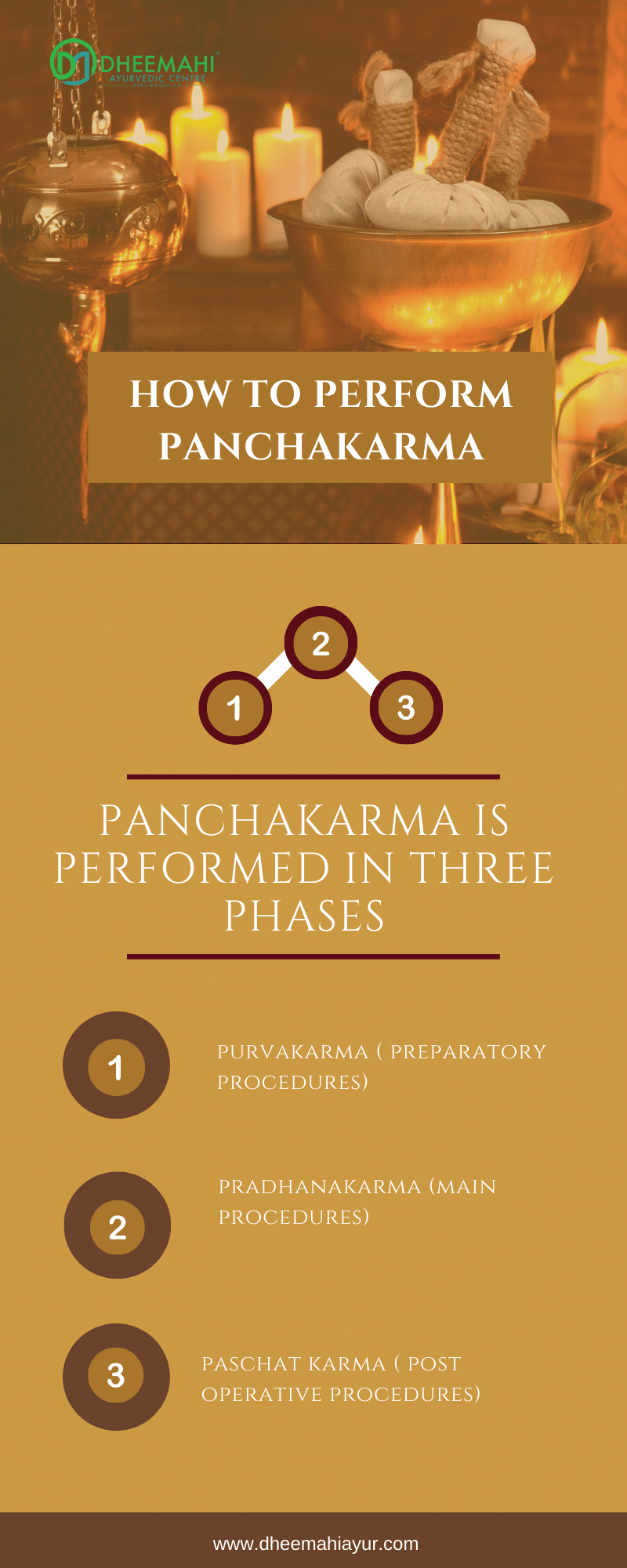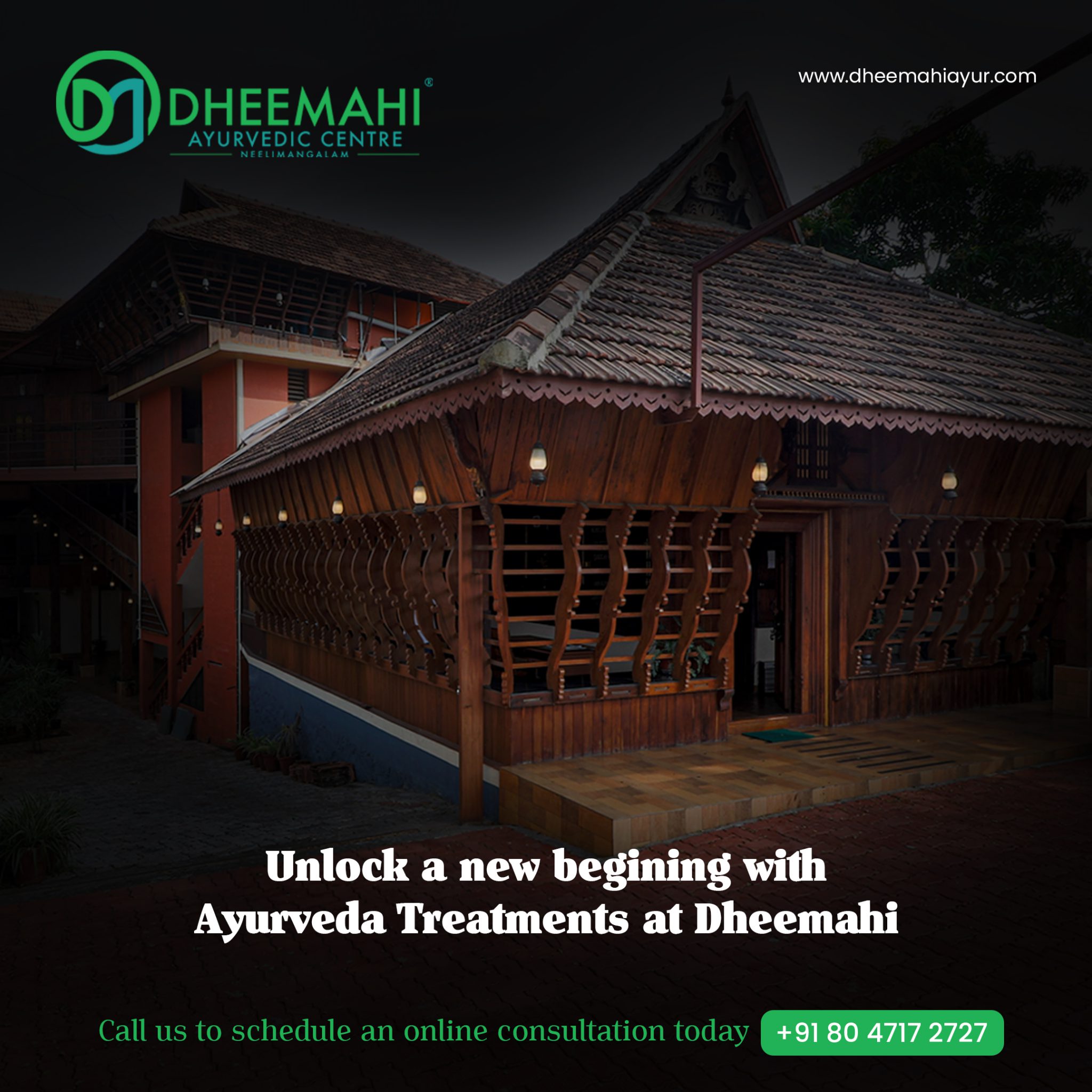Role Of Panchakarma In Ayurveda
— Dr. Karthu Satheesh B.A.M.S
When the word ‘Panchakarma’ comes to our mind, we all criticize that word into some treatment procedures like uzhichil, pizhichil,kizhi, etc. Is it panchakarma confined to that particular treatment only? Then, what is panchakarma? What are the procedures coming under the word panchakarma? What are the benefits of panchakarma? As a layman, we have come across such questions about panchakarma.
As we all know, Ayurveda is a holistic science, one of the traditional systems of medicines that promotes a healthy life like any other system of medicine. Ayurveda is the upaveda of Atharva Veda. The word Ayurveda is made of two words such as Ayu and Veda. Here, ayu doesn’t mean life only. It is the sareera indriya satva atma samyoga as per Charaka. Veda means knowledge. Then, Ayurveda means the knowledge of the union of body, sense organs, mind, and soul.The principle that governs to Ayurveda is Swasthasya swasthya rakshanam, athurasya vikara prasamanam cha || (Cha.su.30/28)
The utility of this science is to help in maintain the health of a healthy individual and cure the diseases of a patient. These are a brief description of Ayurveda. Now, it comes to the point of panchakarma. Panchakarma is a special branch of kayachikitsa (one among the ashtangas of Ayurveda).
The most eminent branch of Ayurveda is panchakarma. Why? Why it is so-called ?
Panchakarma is a bio cleansing procedure that provides a unique approach of Ayurveda with internal purification of the body through the nearest possible route which helps the body to attain the homeostasis (ie, the equilibrium of dosha, dhatu, mala) and rejuvenation.The word panchakarma comprises two words such as Pancha and karma. Pancha means five. Karma means ‘bahu ati kartavyatha’ ie, multiple and broad spectrum of action, procedure, or therapy. Therefore, panchakarma means five actions or therapies. It deals with the five pradhanakarmas as well as purvakarma and paschat karma.
What are the five therapies in Panchakarma?
Panchakarmaanaam naamaani – vamanam, rechanam, nasyam, niruhascha anuvasanam | ethaani panchakarmaani kathithaani muneeswarai || (Sar. Utha.)- Vamanam (emetic therapy)
- Virechanam (purgation therapy)
- Niruha vasti (decoction enema)
- Anuvasana vasti (oil enema)
- Nasya (errhine therapy)

How to perform panchakarma treatment?
Panchakarma is performed in three phases such as purvakarma ( preparatory procedures), pradhanakarma (main procedures), and paschat karma ( post-operative procedures).Purvakarma
Purvakarma means preparatory procedures that has been done before the main procedures. Is it necessary in panchakarma? What are the benefits while doing these procedures before the five main procedures? When we step into the description of these questions we should know about the ayurvedic parameters like dosha, bahudoshavastha, Leena dosha, and upasthitha dosha. What are the roles pertaining to these doshas in these panchakarma procedures? Dosha dhatu mala moolam sada dehasya… || (A.Hr. su: 11/1) Dosha,dhatu, and mala are the basic constituents of the human body. Normal functions of dosha, dhatu, and mala that maintain the health and their deranged functions contribute to diseases. Doshas are the primary constituents of the body, which maintains the integrity and refers that the factor which is not only capable of getting vitiation but also vitiating the other factors in the body.There are tridoshas ie, Vata, pitta, and Kapha. They destroy or maintain the body when vitiated or not respectively. There are different avasthaviseshas of doshas like vridha avastha (increased state of dosha), kshaya doshavastha (decreased state of dosha),Leena doshavastha (adhering dosha),utklishta doshavastha(excited state of dosha), etc.

Bahudoshavastha
is one among them in which the vitiated doshas are in excessive quantity where sodhana is indicated. Lakshanas mentioned in the context of bahudoshavastha are indigestion, loss of appetite, exhaustion, eruption of pimples, fatigue,paleness of body,lazyness,loss of physical strength,loss of sleep, depression ,etc.Leena doshavastha
simply means ekadesa sthitha dosha. The dosha that is stick on to a specific area. In our body, the aggravated doshas spread to whole over the body or half of the body or in a particular anga or avayava and give rise to roga there itself. If these doshas resides in that area and aren’t in the state of utklesa avastha, it shouldn’t be expelled by sodhana as it can leads to destruction just like trying to extract juice from an unriped fruit. So, it will be very difficult to expel the dosha with amavastha. Thus, we have to bring the leenadosha into upasthitha dosha.Upasthitha dosha
Chakrapani the commentator of Charaka samhitha who explained that, movement of the accumulated dosha from sakha to koshta and which have changed from their forms from leenatwa to utklesitha avastha can be said as upasthitha dosha. Factors responsible for upasthitha doshavastha are vridhi of dosha(excessive increase of dosha), vishyanda of dosha(liquifaction of dosha), paka of dosha(digestion of dosha), srotomukha visodhana(cleansing of body channels)and vayoscha nigraha(controlling of vata). These transformations of doshas can be achieved by the poorvakarmas.What are the preparatory procedures?
Dipana pachana
It enhances the digestive fire and clear the body channels. This should be done before any sodhana therapy because, it helps to alleviate the amavastha in the body. This can be done by administration of takra or medicines like vaiswanaram churnam,ashtachurnam, amruthotharam kashayam, etc or the procedure like udwarthanam. While doing these procedures the body attain rukshavastha(dryness, roughness).Snehanam
It means oleation therapy which provides snigdhata or oilness in the body. Bahya and abhyantara sneha both are related with the purvakarma. Abhyanga, Murdhataila(siroabhyanga,siro pichu,sirovasthi,sirodhara)are coming under bahyasnehanam. Achasnehapanam(oral intake of medicated or non medicated snehadravya without mixing food items),pravicharana snehapanam ( administration of snehadravya either orally mixed with food items such as gruel,meat,milk,etc or externally like eardrops, massage, enema,..), sadhyasneha (unctous drink prepared with salt oleates an individual instantly in a short period of time) are contributes to abhyantara snehanam. It can be done until samyak snigdha lakshana attained. Good digestive power,softness of the body, vata anulomanam are the signs of proper oleation. Dosha attains the utklishta avastha by this procedure and can expelled out from the body as water can be separated from a pot smeared with oil, likewise, kapha can be taken out from the body of patient by snehana procedure.Who can do snehana and who can’t?
Oleation therapy in general is prescribed for those who have roughness in the body, suffering from vatarogas, those who planned for sodhana chikitsa,excessive indulge in physical activities, alcohol consumption and also children and old age due to their developing and degenerating nature of body respectively. Those who are unfit for oleation therapies are the person who have suffering from diseases like indigestion, loss of appetite, diarrhoea, vomiting, poor digestive fire,fainting,etc.Swedanam
The procedure which induces sweating for therapeutic purpose is known as swedanam. It is usually done after oleation therapy. Swedana is the prime modality of treatment for number of disorders having predominance of vatika and vatakaphadika dosha. All of you are familiar with widely used potalis such as elakizhi, podikizhi,manalkizhi,muttakizhi, njavarakizhi,etc(perspiration induced by using potali known as pindasweda) and procedures like pizhichil( perspiration induced by pouring medicated oil or decoction known as parisheka), sitz bath(dip in a tub containing medicated dravadravya known as avagaha), kshiradhooma(perspiration attained by steam through a tube known as nadi sweda),and most commonly used bandaging(bandaging of medicated paste or oil applied over a specific area known as upanaha) These are coming under the agni type of swedana. Through which swedana is done by direct contact of heat to the body of the patient. Another variety of swedana is anagni type. ie, without involving the direct application of heat. Exercise,wearing of heavy clothing, exposure to sunlight, residing in warm chamber,etc are the anagni type of sweda. Swedana is to be administered until attaining the samyak swinna lakshanas. Relief of coldness,pain, stiffness and heaviness are the samyak swinna lakshanas mentioned by charakacharya. Perspiration promotes the peripheral circulation and vasodilatation of vessels through which it eliminates the metabolic wastes and cleanses the body channels. The person who is suffering from swasa, kasa, pratisyaya like upper respiratory disorders,osteoarthritis, stiffness, tennis elbow, trigeminalneuralgia, facialpalsy, etc like wide range of vatarogas, amanubandham, angamardam,etc are indicated for swedanakarma. Pregnant women, person having bleeding disorders, diarrhoea,etc are unfit for swedana karma.Need of purvakarma
Thaanyupasthitha doshaanaam snehaswedopapadanai | Panchakarmaani kurvita maatra kaalau vicharayan || ( Cha.su.2/15) It will be very difficult to expel the dosha with amavastha. Thus, we have to bring the leena dosha into upasthitha dosha. For that, snehana and swedana karmas are merely the options.By snehana karma, the dosha will attaining utklesithavastha and it is liquified by swedanakarma. Proper sudation administered after oleation therapy makes the body flexible as the dry stick becomes soft, elastic and flexible. As a result of this,the vitiated doshas are made easily expelled out with the help of pradhana karma.Pradhankarma
Pradhanakarma includes five main procedures such as- Vamana(emetic therapy)
- Virechana(purgation therapy)
- Niruha vasthi( decoction enema)
- Anuvasana vasti (oil enema)
- Nasya(errhine therapy)
Vamana
Vamana is the principal treatment which is suggested for kaphaja diseases. Vamana is the procedure in which vitiated doshas are forcefully expelled out through the mouth followed by the administration of vamanoushadi. The drugs under madanadi gana such as madanaphala, yashtimadhu,etc are commonly used for inducing vamana. It should be done preferably in Vasantha rithu(spring season). It should be practiced upto the expulsion of pitta. If the patient has 8 bouts of Vamana, then it will be considered as uthama sodhana.likewise, 6 vega and 4 vega can be considered as madhyama and avara sodhana respectively. Vamana has priority than virechana Because,if virechana is administered without Vamana,the aggravated kapha descending to the koshta and which makes an upalepa over the amasaya as a result of this, the digestive fire will be reduced and it leads to agnimandya, praseka, and pravahika.That is why Vamana hasbeen kept ahead of virechana in panchakarma therapy. Vamana is indicated for those who are suffering from kaphadhikya rogas, kushta, unmada,apasmara,pinasa,visarpa, stanyaroga,etc. Contraindicated persons are pregnant women, those who are at the age of sixty and above and the person doesn’t attain snigdatwam in body after purvakarma, those who are suffering from heart diseases,exhaustion, anxiety,atyagni, arsas, mutraghata, indulging in excessive exercise,etc.It may cause some complications such as fainting,dyspepsia, haematemesis,etc and it should be treat symptomatically. Sadyovamana means immediate vomiting. It is an easy and time saving procedure with minimum strain and it can be given irrespective to kala when compared to the classic vamana and can be done in emergency conditions, kapha utklesitha avastha also. Navajwara, tamaka swasa, ajirna, trishna are the indicated conditions for sadyovamana. For this, 1-2 litres of yashtimadhu kashaya, lukearm water with salt,etc these can be used according to the condition of rogi and rogavastha.Virechana
virechana is the second therapy and it is the most commonly used sodhana therapy especially for paittika and pittanubandha conditions. In this, the prakupitha doshas expelledout through the anus. There are two types of virechana that is, snigdha and ruksha. Snigdha virechana indicated in the conditions like wide spectrum of vatavyadhis like gridhrasi(sciatica),pakshaghatam(stroke), katigraha(lowback ache),etc by the use of oil such as eranda preparations. (Eg: sukumara erandam, nimbamrutha erandam,..) Ruksha virechana indicated in kushta, amlapitta, kamala,udararoga,etc by the use of churnas like avipathi churna, triphalachurna, sukhabhedi gulika,….). It should be given after kaphakala. Kaphantha condition is the desirable end point of virechanakarma. 30 Vegas can be considered as pravarasudhi likewise, 20 and 10 Vegas considered as madhyama and avara sudhi respectively. Indication of virechana includes, It should be given to a person who has undergone snehanakarma, swedanakarma and vamanakarma. The person who suffering from diseases such as amlapitta, sirasula,pakshagata,kushta,yoniroga, krimiroga,etc. virechana is not performed in the conditions such as amavastha, ajirna,agnimandya,or having gudapaka, krura koshta,atisara,etc.Niruhavasthi
Otherwise known as kashaya vasthi or asthapana vasthi. Introduction of medicated decoction through the anal route by the use of vastiyantra is known as vasthi. Vasthi can be considered as chikitsardha ie, it is the prime treatment modality among the panchakarma because it has curative as well as preventive action. Ingredients of niruhavasthi includes a homogeneous mixture of madhu,saindhava ,sneha, kalka and kwatha. It should be given during morning hours and the patient lie down in the left lateral position on the droni with calm and relaxed mind. After the injection of vastidravya, the patient immediately runs to the toilet and evacuates bowel. Immediately after that,he/she should take riceporridge to prevent vayukopa. The person who are fit for niruha vasthi are having vatavyadhi, malasanga, rajakshaya, adhmana, angasupti, gulma, hridroga,bhangandara, unmada,etc. The person who are unfit for niruha vasti are those who having ajirna,mandagni, delirium,fainting, breathlessness,hiccough, ascites, intestinal perforation,and those who undergone Vamana and virechana, etc.Anuvasanavasthi
Known as sneha vasthi. Medicated oil is used for this type of vasthi. It can be done immediately after lunch. Evacuation time is quite longer than that of niruha vasthi. The quantity of medicine is 1/4th of niruhavasthi. It has brmhana action also. Indication and contraindication of anuvasanavasthi is same as that of niruha. Matravasthi is a type of snehavasthi. It is a miniature form of vasthi. 60-90 ml is the dose prescribed for matravasthi. It can’t be given in amavastha. Otherwise it is fit for bala, vrudha,long walking persons,persons who indulging in excessive exercise and having history of chronic constipation,etc.Nasya
Medicine which is administered through the nasal route is termed as nasya. It is beneficial for urdhwajatrugata vikaras. Mainly It is of 2 types ie,marsa and pratimarsa. Instillation of nasya oushada in higherdose considered as marsa and in smaller dose is termed as pratimarsa and it is to be considered as satmya from birth itself. Benefits of nasya includes prevention against urdhwajatrugatarogas, ensure healthy parts of above neck, enhances the activity of indriyas. It can be given for all type of jatru urdhva vikaras, vatavyadhi like apabahuka, psychiatric disorders, nasarsas,etc. It can’t be given in amavastha, ajirna,rainy season also those who are under Vamana, virechana and vasthi,etc.Paschatkarma
It is the aftercare measures which includes immediate measures like dhoomapana, kabala which is given after nasyakarma only and late measures like samsarjanakrama(dietary regimen) and brimhana therapy (nourishment therapy) can be given after Vamana and virechanakarma. Samsarjana not done in nasya and vasthi. In vasthi, there isn’t much agnimandya as that of Vamana and virechana.so,in vasthi mamsarasa canbe given in the place of samsarjanakrama.Importance of samsarjanakrama
As per the commentator chakrapani, the physiological state after sodhana is doshakshaya and dhatukshaya. After sodhana, agnimandya occurs immediately and gradually agnidipthi is attained. For this conversion peyadikrama is given. It is given in visudhakaya in order of peya(gruel with excess fluid), vilepi(gruel with less fluid), akritha yusha(soup of pulses without oil), kritha yusha(soup of pulses with oil), akritha mamsarasa(meat soup without oil) and kritha mamsara(meat soup with oil). Each diet can be taken for two or three annakalas according to the type of sudhi. For uthamasudhi,it can be given for 7 days.likewise, 5 and 3 days are suggested for madhyama and avarasudhi respectively. Aim of samsarjanakrama : ● Suppliment of liquid and nutrition ● Improving agni ● Adaptation to regular diet and bring to normalcy ● Overcome doshakshaya and dhatukshaya Brimhana chikitsa : After Vamana virechanakarma,dosha and dhatu attain kshayavastha. So, pathyahara like ghrita, mamsarasa, ksheera,yusha,etc should be given to regain strength of the body. Criteria for diet selection: ● Food should enhances agni ● Get digest easily ● Absorb easily ● Heal the alimentary canal ● Restore the bala and atlast should cause satmya.Importance Of Panchakarma
A long healthy life is the wish of every person since antiquity. Diseases are the destroyers of health, wellbeing and life. Ayurveda aims at restoration of health by attaining dharma (pious acts), artha (wealth), kama(desire), moksha(salvation). Those who are seeking a healthy life should attain these four purusharthas by health. Panchakarma plays a vital role in the preservation, maintenance and conservation of health and it makes the biological system to maintain the normalcy, rejuvenate the body and facilitate the desired effect of therapeutic measures that are administered thereafter.

